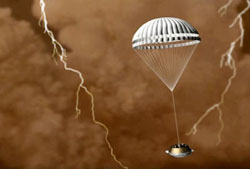This area deals with the fundamental laws and building blocks of nature and how they interact, the properties and the behavior of matter, and research into space and time and their structures.
innovations-report provides in-depth reports and articles on subjects such as astrophysics, laser technologies, nuclear, quantum, particle and solid-state physics, nanotechnologies, planetary research and findings (Mars, Venus) and developments related to the Hubble Telescope.

Nanoscientists dream of developing a quantum computer, a device the size of a grain of sand that could be faster and more powerful than today’s PCs. They’ve identified tiny artificial atoms – called “quantum dots” – as the most likely materials to build these machines, but have been puzzled by the dots’ unpredictable behavior at the nanoscale.
Now a team of Ohio University physicists thinks it’s found the problem – and has proposed a blueprint for building

A sensing device tailored for mass production of highly sensitive and stable nerve-gas detectors has been developed by a research group led by a mechanical engineer at The University of Texas at Austin.
The new sensor technology, which was more sensitive and much more stable than its predecessors, was featured on this week’s cover of Applied Physics Letters. The researchers’ highlighted study demonstrated the sensor’s potential ability to detect a single molecule of the nerve ga

Contrary to conventional wisdom, technology’s advance into the vanishingly small realm of molecules and atoms may not be out of sight for the venerable optical microscope, after all. In fact, research at the National Institute of Standards and Technology (NIST) suggests that a hybrid version of the optical microscope might be able to image and measure features smaller than 10 nanometers–a tiny fraction of the wavelength of visible light.
In a preliminary test of the embryo

Two top research teams at the University of Southampton have this week secured a funding boost worth over £11 million between them. The two research groups, working in NanoPhotonics and Photonics, were among six groups nationwide to receive long-term funding support under the Portfolio Partnerships initiative launched by Lord Sainsbury.
Southampton is the only university to receive two of the new batch of Portfolio Partnerships, securing over half the £22 million funding awarded

BU team’s nanomechanical device bridges classic and quantum physics
Nanotechnology leapt into the realm of quantum mechanics this past winter when an antenna-like sliver of silicon one-tenth the width of a human hair oscillated in a lab in a Boston University basement. With two sets of protrusions, much like the teeth from a two-sided comb or the paddles from a rowing shell, the antenna not only exhibits the first quantum nanomechanical motion but is also the world’s fastest mov

Using a global network of radio telescopes, scientists have measured the speed of the winds faced by Huygens during its descent through the atmosphere of Titan.
This measurement could not be done from space because of a configuration problem with one of Cassini’s receivers. The winds are weak near the surface and increase slowly with altitude up to about 60 km, becoming much rougher higher up where significant vertical wind shear may be present.
Preliminary estimates